014

In 480 B.C.E. the Persians invaded Athens. According to the Greek historian Herodotus, they “plundered the temple and burnt the whole of the Acropolis.”1 Although the Athenians and their allies followed up with a victory at the famous naval battle of Salamis, the Persian army returned the following year and “burnt Athens and utterly demolished whatever wall or house or temple was left standing.”2 Ten years earlier, in 490 B.C.E., the Persian king Darius had invaded Greece, only to be thwarted on the plain of Marathon northeast of Athens. The devastating attacks of 480 and 479 B.C.E. were the revenge of Darius’s son and heir, Xerxes.
015
The Greeks forced the Persians to retreat from the country shortly after the second sacking of the city (though the Persian Wars would continue for another 30 years). The Athenians then “prepared to rebuild their city and their walls,” according to the Greek historian Thucydides (c. 460–400 B.C.E.). “For only isolated portions of the circumference had been left standing, and most of the houses were in ruins.”3
The city and its defensive walls were the first order of business—not the Acropolis, which also lay in ruins. The Acropolis was cleaned up enough to permit worship at its altars, and the gate was made secure again to protect not 016only the sacred places but the state treasury, which was kept on the Acropolis. So it wasn’t until the Persians had been fully vanquished and peace declared that the Athenians turned to repairing the Acropolis.
Fortunately, the Persian destruction of the Acropolis was not as complete as the ancient historians imply. Still standing, for example, were portions of the Old Temple of Athena, which housed the image of Athena Polias, the city’s patron deity. In addition, the so-called Older Parthenon, a temple that was under construction when Xerxes attacked, was still partially standing, though burnt and severely damaged. Nonetheless, the Acropolis we think of today, an imposing fortress-like hill with four magnificent buildings—the Parthenon, the Propylaea (entrance building), the Temple of Athena Nike and the Erechtheum—is almost entirely a creation of the second half of the fifth century B.C.E.
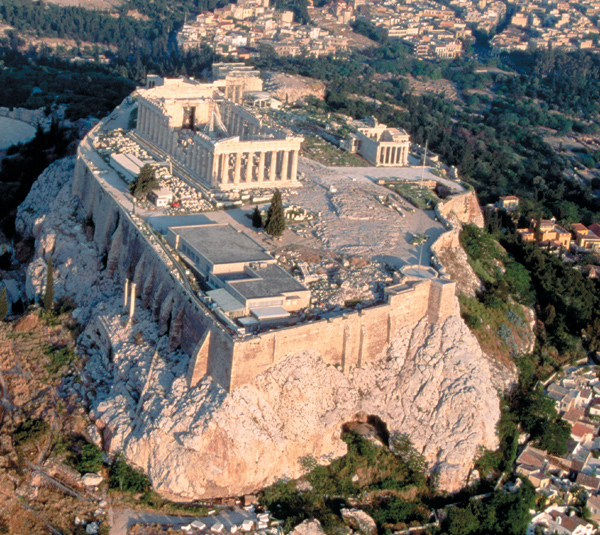
Much of the work took place under the auspices of Athens’s leader Pericles (c. 495–429 B.C.E.), who intended to make the Acropolis a lasting memorial to the Greek spirit and to the glory of Athens. However, all who worked on the Acropolis were constrained by the remains 017of the buildings damaged by the Persians and the requirements of the cult places on the Acropolis.
The first structure erected as part of Pericles’s renovation of the Acropolis was the Parthenon, which was designed by the architect Ictinus with the aid of Callicrates. The Parthenon was built between 449 and 437 B.C.E., and it was built on the platform of the Older Parthenon. That platform was both enlarged and shifted for the new structure, and much of the damaged material from the Older Parthenon was used in the new structure. Recent examinations of the walls of the Parthenon, for instance, show that wall blocks from the Older Parthenon were re-used but reversed so that the damaged surfaces could not be seen.
In design, the Parthenon is a fairly typical Greek temple, though it was larger than most (228 feet by 101 feet) and built entirely of marble quarried at nearby Mt. Pentelikon (visible near the road into Athens from the new airport). The core of the structure is a simple rectangular building divided into two rooms, which are entered from the outside (that is, from opposite ends of the core). The larger, east-facing room is the temple’s cella, or cult room. The smaller, west-facing room, or opisthodomos, would have held offerings and other valuables in antiquity. In front of each room is a shallow portico, itself fronted by a line of six columns. A colonnade of 46 Doric columns encloses the core and porches—eight columns on the ends and seventeen on the long sides (counting each corner column twice). In antiquity, the entire structure was also covered with a roof, now almost entirely missing. Even the roof tiles were carved of marble rather than molded of terracotta.

The Parthenon represents the culmination of skills and traditions that had guided the Doric style in Greek architecture over the preceding centuries, and it can be seen as the ultimate achievement of architecture guided by a craft tradition. Much of what makes the Parthenon so magnificent involves an artistic subtlety that cannot 018be planned mathematically but stems from an individual stone mason’s training and experience and the accumulated experience passed down over generations.
For example, the floor of the Parthenon is not flat. Its four corners lie approximately at the same elevation, but the floor curves slightly upward (rising from the corners to the middle of each side, and rising still higher to the center of the building), so that the surface is convex, with the lowest points of the floor at the corners and the highest point at the center. Whether this design was a practical requirement for shedding rain water or an optical refinement to make the floor appear flat is irrelevant. It endows the structure with a sculptural quality. Only skilled, experienced masons could have accomplished this design.
This sculptural quality is enhanced by the designs of the columns. The diameter of each column is reduced from bottom to top, but not continuously; instead, the columns curve and swell along their edges so that they are often said to be cigar-shaped. Modern neoclassical 019buildings rarely employ this subtlety (called entasis), and their columns, as a result, seem brittle, ready to snap. By contrast, the Parthenon’s columns (and those of most ancient structures) seem to have accepted the weight they bear and to be prepared to stand for eternity.
The columns are also positioned as a sculptor, rather than an engineer, would place them. They are not vertical; they lean slightly back, toward the core of the structure, out of plumb by about one centimeter. This attention to detail can also be seen in the corner columns, which lean slightly back toward the diagonally opposite corner. The corner columns are also 020a little larger in diameter than the others.
The columns are also unevenly spaced around the perimeter of the temple. The nature of the Doric triglyph-metope frieze (see box) creates a conflict at the corners. As a result, the corner columns and the columns next to them have been adjusted to create spacing that may appear to be regular but is not. The frieze was also adjusted so that the final effect is of both a regular frieze and a regular colonnade, though both are subtly irregular.
The Parthenon’s entablature isn’t horizontal either. The beams of the architrave and the frieze directly above it share the curvature of the floor, rising from corner to center and falling again from center to corner, making the entire structure seem elastic and alive—a surprising effect, given the use of so solid a building material as marble.
All the subtle adjustments in the Parthenon’s design made it impossible for most of the blocks of the structure to be cut as simple right-angled blocks. Each was, in the end, carved to fit its particular spot, with surfaces that might be curved rather than flat and that might not be at right angles to one another. The skill and training of the masons were essential.
As a temple and the home of the warrior-virgin Athena, known as Athena Parthenos, the Parthenon’s sculpture illustrates mythico-religious themes. The birth of Athena and the struggle between Athena and Poseidon to become Athens’s patron filled the two pediments, and various other mythical contests filled the metopes.
Pericles chose Phidias (c. 465–425 B.C.E.), the most famous Greek sculptor of the day, as supervisor of the sculptural program for the building. (Phidias was also selected to supervise the planning of the Acropolis as a whole.) Phidias’s own great sculpture, the statue of Athena gazing out toward the altar, stood in the cella. Made of ivory and gold on a core of wood,a the sculpture depicted a helmeted Athena holding a spear in one hand and a figure of the victory goddess Nike in the other. Though long since destroyed, the statue is well known to us, as it was often shown on ancient coins, and it was described in great detail by the second-century C.E. Roman traveler Pausanias: “The statue of Athena is upright, with a tunic reaching to the feet, and on her breast the head of Medusa [Athena’s emblematic Aegis] is worked in ivory. She holds a statue of Victory about four cubits high.”4 (Since four cubits were about 6 feet, Athena held a life-size statue in her hand.)
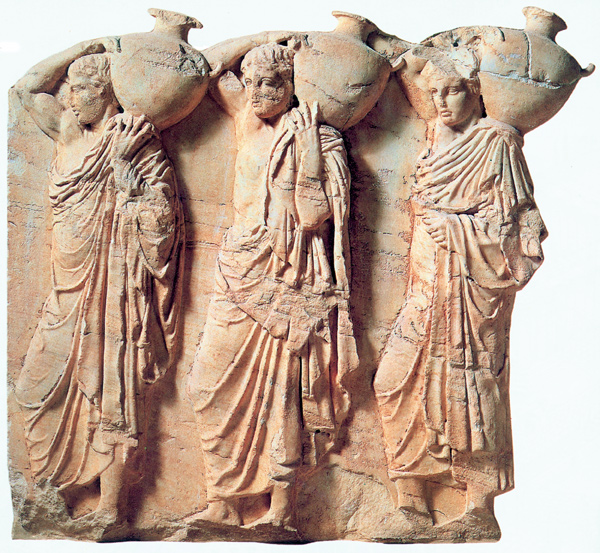
022
The most famous portion of the Parthenon’s sculpture was the continuous frieze band that lay above the outer wall of the core, facing outward. This positioning meant that the frieze was obscured by the entablature; it was thus visible only from below and only with the aid of reflected light reaching into a naturally dim area. (This kind of positioning was never again used in antiquity, suggesting that its disadvantages were recognized.) Indeed, given that the frieze was so difficult to see, its fame is a testament to its beauty.
Once about 524 feet long,b the frieze depicted a procession of young horsemen, older men, chariots, cattle and horses, youths bearing jars on their shoulders, musicians, men possibly serving as parade marshals and a few women, most of them carrying ritual vessels. The parade was really two parades, both beginning at the southwest corner: One group moved east along the south side of the building, then north along the east facade; the other group moved north along the west facade, east along the north side of the building, and then south along the east facade to face the other group. The two groups converged to face the culminating scene above the east portico. There the Olympian gods, seated, watched a ceremony most commonly interpreted as the presentation of a new peplos (an ancient garment) to Athena. This procession may depict the central event of the Greater Panathenaea (held every four years), when such a garment was brought to the Old Temple of Athena to adorn the image of the goddess (in fact, however, our knowledge of the meaning of the frieze is not very certain; we will probably never know exactly what was depicted on it).
The Parthenon looks very different today from the way it looked in the fifth century B.C.E. Today we see the soft, subtly changing tones of weathered marble—023gray in dull light, almost white in the bright sun, and a warm golden color at sunset. But in antiquity the Parthenon’s sculptures and the building itself were enlivened with color. The overall effect must have been stunning, with even moldings and portions of the ceilings painted red, green, blue or gold. So fixed is our impression of what a Greek ruin should look like that we would undoubtedly be shocked, perhaps even outraged, if some present-day restorer took it upon himself to splash a variety of colors on the Acropolis. Our outrage, of course, would be entirely misguided.
The Parthenon was built in a very short time, from 449 to 437 B.C.E., though the sculpture was not completed until 432. The speed of the building process is remarkable. In one sense, though, it was never finished, since Athenians continued to nail small dedications to its walls in the years following its erection.
The construction of the Parthenon had just been completed—though not the sculpture—when a monumental entrance structure for the entire precinct was started: the Propylaea, through which all who enter the Acropolis must pass even today.
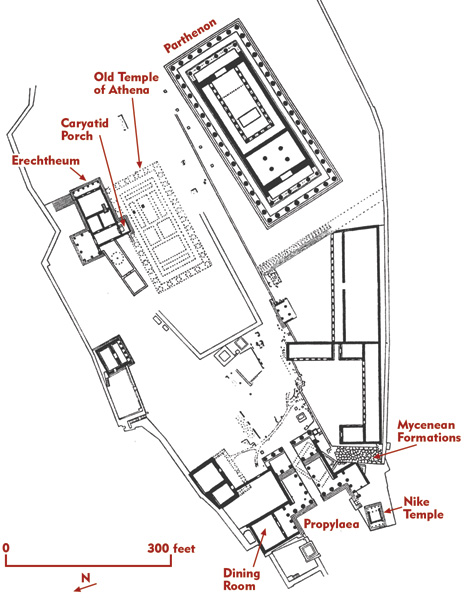
Like the Parthenon, the Propylaea replaced an earlier less-impressive structure. Designed by an architect named Mnesicles, the Propylaea was built to fulfill three primary functions: It would guard the entrance to the Acropolis, preventing thieves, runaway slaves and the unclean from entering;c it would include a room for ritual dining; and it would provide access to the sanctuary of Athena Nike. Mnesicles’s task was quite different from that of his colleague Ictinus, the architect of the Parthenon. Not only did his building have to serve multiple unrelated functions but he had to build it on a very steep slope.
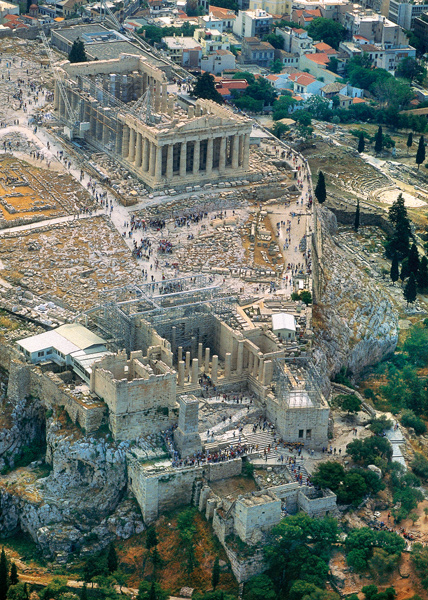
If Ictinus was essentially a sculptor working on a large scale, Mnesicles resembled more a modern architect or engineer. He could have designed three separate buildings to fulfill the required functions, but he made the more difficult and more aesthetically satisfying choice of creating a unified structure, a task that required a complexity of design unknown in previous Greek architecture. Mnesicles needed to plan his structure more fully and carefully than did his contemporaries working on other buildings—despite the fact that his planning tools were, to the best of our knowledge, extremely limited. Scaled drawings were unknown, and we have no evidence for scale models. He could not rely on masons and their experience for the complexities; the building he conceived went well beyond their experience, as well as his own.
The core of the Propylaea is a deceptively simple rectangular structure with a wall dividing it into two 024porches—a western and eastern porch—each with a six-column colonnade on its exterior. (Thus Mnesicles presented two temple-like facades, with columns and a pediment above, one to visitors entering the Acropolis and one to those leaving the Acropolis). To enter the sanctuary, one walked up the steps into the outer porch, passed through one of the five doorways in the wall into the inner porch, and then entered the Acropolis.
The outer porch offered shelter to those waiting for the sanctuary to open, so it was deeper, occupying about two-thirds of the depth of the whole. To make the structure more complex, Mnesicles designed the eastern porch at a slightly higher level than the western porch (the roof level is also raised, but not as much); visitors had to climb five steps before passing through one of the doorways into the eastern porch. This change of levels was required by the difficult, steeply-pitched site; it allowed visitors to reach the level of the Acropolis while passing through the Propylaea.
Grafted onto the central building were two wings, both on the west side and therefore lower than and outside the sacred area of the Acropolis. The northwest wing seems to have been a room for ritual dining, with a shallow colonnaded porch in front. The southwest wing only provided a passage to the small sanctuary of Athena Nike. Although the southern wing was much shallower and only about two-thirds as wide as the northern one, the two wings present virtually identical facades to the visitor who looks left and right while passing into the central building. However, the apparent symmetry is the architect’s conceit. The two wings are quite different in plan.
A U-shaped platform, one of Mnesicles’s crucial innovations, draws together the central building and two western wings, ensuring that all three of these structures lie at the same elevation, even though the facades of the two wings are much smaller in scale than the facade of the central building. Indeed, the two wings and the central building of the Propylaea have virtually no common structural elements other than the platform. Each rises independently from that platform, and the small walls that connect each wing to the central building are structurally unnecessary. 026Yet when looking upon it from the west, the entire structure appears to be a fully unified whole.
There were to have been two other wings on the eastern side of the building, but neither was completed. The southern wing on the east side was apparently abandoned rather early in the building process, but the northern wing seemed to have been intended up to the moment construction stopped. Unlike the western wings, the eastern ones presented serious structural complications and truly novel problems to the architect, who could not have completed them as intended without significant changes to the central building and possibly the western wings.d
What Mnesicles tried was daring because it was novel; it required a kind of conceptual thinking new to architects of antiquity who were accustomed to slow, evolutionary changes to intensely conservative forms. Whereas the Parthenon represents the culmination of the conservative temple form, the Propylaea represents the emergence of a more revolutionary approach to architectural forms. The essential vocabulary has not changed, but the concept here is new. It is the idea that a building can transcend its past. The complexity and the (false) symmetry are new, to be sure, but what is revolutionary is the idea that an architect can invent something truly new.
The Propylaea also shows us an architect working to push the limits of his materials. Mnesicles let iron bars into the tops of some beams so that the crossbeams above would rest on the iron bars rather than the marble beams; he even left room for the bars to give as weight bore down upon them. Although he lacked the analytic tools to determine the effect of the experiment (which, in fact, reduced the load-bearing capacity of the beams), he was attempting to go beyond his predecessors here as well.
The masons who worked on the Propylaea were almost certainly the same masons who had worked on the Parthenon, and they worked some of their magic here as well. The structure’s coffered ceilings, for example, made of wonderfully carved marble blocks painted blue with gold stars, were still impressive 600 years later when Pausanias declared them to be “down to the present day unrivalled.”
Both Ictinus and Mnesicles were firmly rooted in the Doric tradition, but both experimented with Ionic elements in the buildings they created. Ictinus used the more slender Ionic columns only in the opisthodomus (or western chamber) of the Parthenon. Mnesicles, on the other hand, brazenly used Doric for the exterior colonnades of the Propylaea and Ionic for the columns on either side of the passageway running down the middle of the central building. This design allowed for the Doric columns of the facade and the Ionic columns of the interior to be visible at the same moment—quite a revolutionary choice.

The smallest of the Acropolis structures, the Temple of Athena Nike, is a fully Ionic building. It stands at the westernmost reach of the precinct, above the natural bedrock and the earlier walls that had been sheathed in well-cut masonry as part of Pericles’s overall plan. In 1686 the Ottoman Turks completely demolished the building, salvaging its stone for the construction of fortifications. The temple has been reconstructed several times using blocks retrieved from that fortification, with each version attempting to correct errors made by previous builders. At the time of this writing, in fact, the temple is being reconstructed yet again.

The original Nike temple, completed about 425 B.C.E., did not have a fully enclosing colonnade. Instead, four columns graced each of the facades (east and west). In addition, the small site upon which the temple was built required that the porches behind those facade columns be relatively shallow. The balustrade that surrounded the precinct provided the setting for relief sculptures, including the famous depiction of the goddess Nike fixing her sandal, now in the Acropolis Museum. That figure epitomizes the small Nike temple—graceful, light, almost ethereal. If the Parthenon, constructed at the height of Athens’s economic and military power, symbolized the city’s grandeur and lofty ambitions, the diminutive Nike temple seems to foreshadow Athens’s narrower aspirations after the Peloponnesian War (431–404 B.C.E.), the long conflict between Athens and Sparta chronicled so memorably by Thucydides.
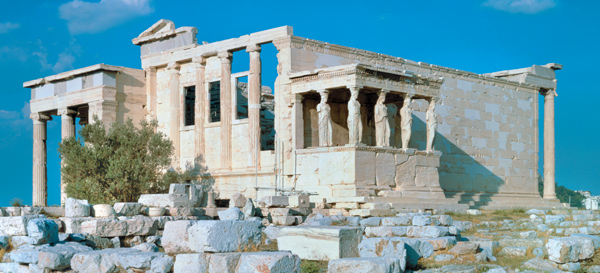
The last of the structures on the Acropolis, the Erechtheum, was also built entirely in the Ionic style. By all odds, it should have been the first to be built, since it housed the Athenians’ most important image—the statue of Athena Polias, the city goddess. This primitive wooden image was said by Pausanias to have fallen from the sky. It was adorned with a new garment (peplos) every four years as part of the Greater Panathenaea, a celebration that was even more elaborate than the annual Lesser Panathenaea. Both festivals included 028religious ceremonies, but the Greater Panathenaea also included contests, both athletic and musical, as well as the great procession culminating in the presentation of the new peplos. However, the Erechtheum was not begun until about 420 B.C.E., and it was not finished until nearly the turn of the century, because work was halted during the later years of the Peloponnesian War.
Like the Propylaea, the Erechtheum lies on difficult terrain, falling sharply downhill to the north. The ritual activity inside the Erechtheum involved a variety of cults, and the building included sacred areas for Athena Polias, Erechtheus (a mythical king 029of Athens), Boutes (the mythical priest and brother of Erechtheus), the god Poseidon and Cecrops (another mythical king). The location of each of these areas was specified and had to be honored by the architect.
As a result of the building’s many requirements, the Erechtheum is not an unqualified success. To a relatively simple—but two-leveled—rectangular building have been inelegantly grafted two porches that are on opposite sides of the core (north and south) but are not related to one another in terms of scale, style, elevation or position. The result is a much less unified structure than the Propylaea; the Erechtheum seems more of a pastiche than single creation. (Adding an unfortunate but necessary insult to this design, the modern restoration of the 1980s includes new, whiter blocks on the major walls of the building. The marble has already weathered and become less distinctly different; over time the difference will become less and less visible. In the meantime, however, the building looks strangely diseased. When the weathering has made the stones indistinguishable by color, surface treatment will still show clearly which blocks are new and which old.)
We don’t know who designed the Erechtheum, but 051lengthy inscriptions concerning the Erechtheum survive, partly because the work was stopped for a time and an inventory of its unfinished state was required. The inscriptions tell us that everyone who worked on the building—architect and mason, citizen and slave—received the same daily wage of one drachma. They also relate that about half the work force consisted of foreigners, and nearly as many of the Athenian workers were slaves as were citizens.
The major facade of the Erechtheum (the east facade) has six Ionic columns. The north porch has another Ionic colonnade. Above the walls ran a continuous sculpted frieze consisting of painted marble attached to a gray stone background. Only fragments remain today.
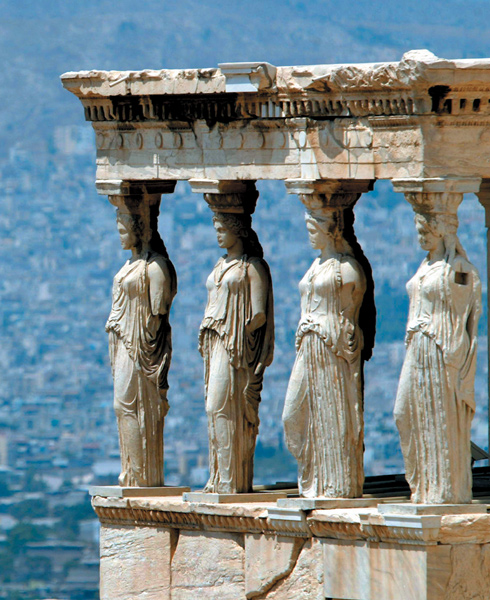
The south porch, facing the Parthenon, also features a colonnade—but the marble columns here assume the shape of maidens, the beautiful caryatids.e The caryatid porch has made the Erechtheum famous, and justly so. The graceful figures seem entirely comfortable with the weight bearing down on their heads. They stride forth gracefully, as if in procession, the three maidens on the viewer’s right advancing their right legs, the other three putting forth their left legs. These marble maidens give the building a sense of lithe elegance and delicacy.
The magnificently refined and sculptural Parthenon, the complex and innovative Propylaea, the enchanting caryatids of the Erechtheum and the small, graceful Nike Temple—these are what, together with the imposing hill on which they stand, have cast a spell over so many, not only scholars and antiquarians, but poets, artists and ordinary tourists. I first started working on the Acropolis in February of 1975, when people could wander about the Acropolis more or less as they wished. One day a French tourist wandered over to where I was working. He looked down into the area of the remains of the old entrance and saw, much to his surprise, a very cold archaeologist. We chatted briefly, and he told me that, having seen the Acropolis, he could now die in peace. I was young enough to be amused rather than moved, but the moment has stuck with me ever since.
The Acropolis is not just an imposing site with beautiful, battered buildings from the remote past. It is visible, tangible proof that we humans can create magnificent, enduring works of true genius.
In 80 B.C.E. the Persians invaded Athens. According to the Greek historian Herodotus, they “plundered the temple and burnt the whole of the Acropolis.”1 Although the Athenians and their allies followed up with a victory at the famous naval battle of Salamis, the Persian army returned the following year and “burnt Athens and utterly demolished whatever wall or house or temple was left standing.”2 Ten years earlier, in 490 B.C.E., the Persian king Darius had invaded Greece, only to be thwarted on the plain of Marathon northeast of Athens. The devastating attacks of 480 and 479 B.C.E. were the […]
You have already read your free article for this month. Please join the BAS Library or become an All Access member of BAS to gain full access to this article and so much more.
Already a library member? Log in here.
Institution user? Log in with your IP address or Username
Footnotes
Plutarch, the Roman historian, reports that Phidias had been advised by Pericles to make all the gold on the statue removable so that it could be weighed and accounted for, in the event the sculptor was accused of theft; indeed, such a charge was brought, so the plan was indeed well-advised.
Almost half of the frieze was removed by Lord Elgin in the early 19th century and placed in the British Museum in London. See Jacob Rothenberg, “Lord Elgin’s Marbles: How Sculptures from the Parthenon Got to the British Museum,” Archaeology Odyssey, Spring 1998.
By the time the Propylaea was constructed, the Acropolis itself was no longer fortified. After the Persians departed, walls were constructed to encompass much of Athens, not just the Acropolis.
The standard view is that the Propylaea was not finished because of the Peloponnesian War. I believe that construction was stopped because the northeast wing could not be built without modifications to the central building and the northwest wing.
